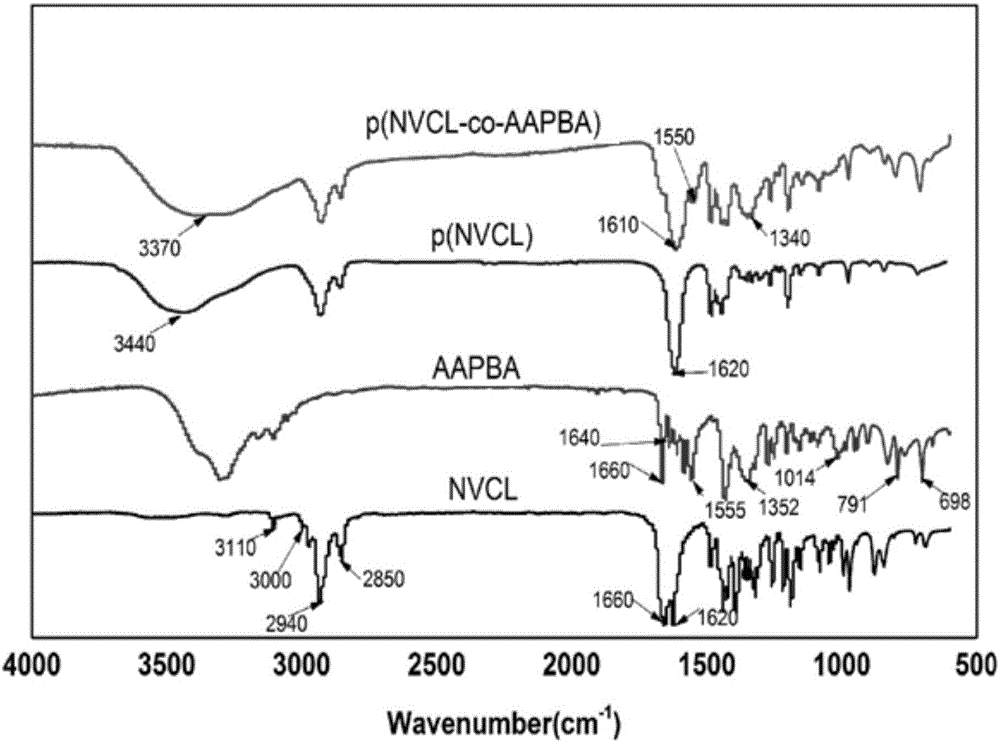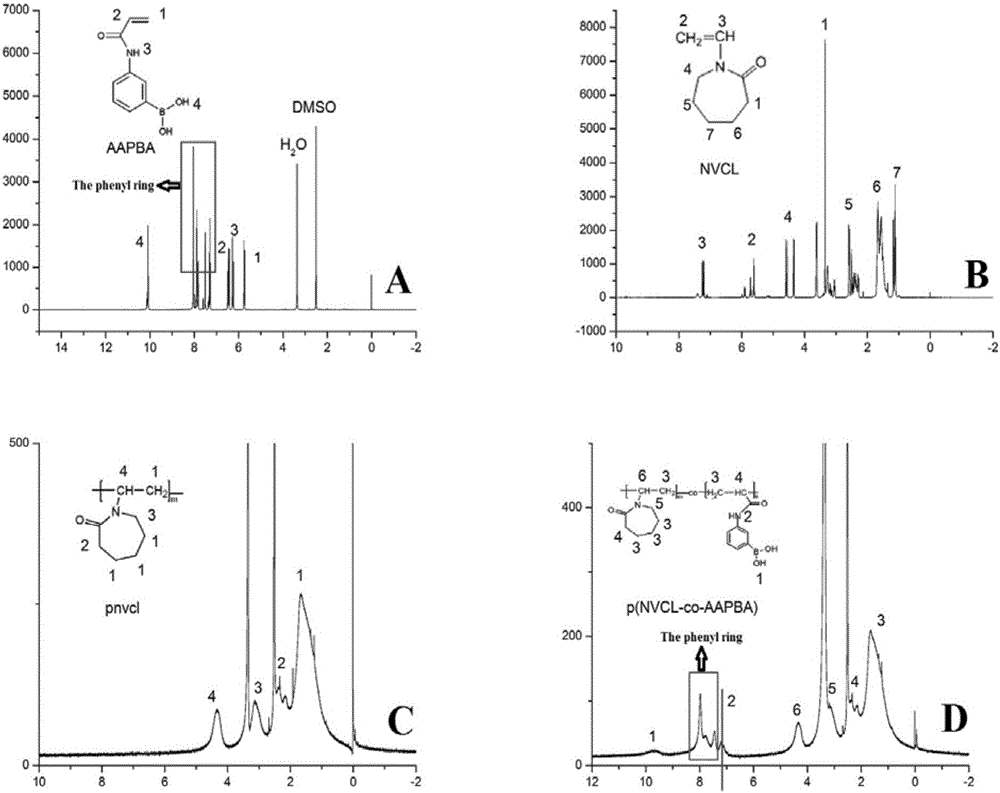Self-assembled nanoparticles having glucose sensitivity and temperature sensitivity and preparation method of nanoparticles
A nanoparticle and sensitive technology, applied in the field of self-assembled nanoparticles and its preparation, can solve the problems of poor water solubility and unsuitable drug-carrying system, and achieve the effects of no toxic and side effects, good clinical application value, and simple operation.
- Summary
- Abstract
- Description
- Claims
- Application Information
AI Technical Summary
Problems solved by technology
Method used
Image
Examples
Embodiment 1
[0044] (1) Weigh 100mg of AAPBA and 1000mg of NVCL; add 1mg of AIBN at the same time, mix all the above materials and dissolve in 1mL of DMF, fill with nitrogen, 70°C, and react for 8h to generate p(NVCL-co-AAPBA).
[0045] (2) Weigh 10mg of p(NVCL-co-AAPBA), dissolve it in 10mL of ultrapure water, and rotate it for 3 hours at a low speed of 300r / min to form p(NVCL-co-AAPBA )Nanoparticles.
[0046] (3) Accurately weigh 2 mg of p(NVCL-co-AAPBA), and characterize it with a Fourier transform infrared instrument, such as figure 2 shown. AAPBA presents 6 main characteristic peaks, respectively the absorption peak of C=O (1660cm -1 ), the absorption peak of C=C (1620cm -1 ), the absorption peak of O-B-O (1352cm -1 ) and the absorption peak of B-O (1014cm -1 ), the absorption peak of the benzene ring is located at 1555cm -1 to 1610cm -1 between, while the benzene ring is at 698cm -1 and 791cm -1 There is also a faint absorption peak. Between p(NVCL) and p(NVCL-co-AAPBA), t...
Embodiment 2
[0049] Basic properties of the nanoparticles obtained in Example 1.
[0050] (1) Weigh multiple portions of 1mg p(NVCL-co-AAPBA) and dissolve them in aqueous glucose solutions with different concentrations (0g / mL, 1g / mL, 2g / mL, 3g / mL) Solution (pH values are 5.5, 6.0, 6.5, 7.0, 7.5, 8.0, 8.5) and solutions at different temperatures (12 degrees to 37 degrees, measured every 5 degrees), after rotating at a low speed for 10 hours, use DLS to measure the particle size. path. in, Figure 5 is the particle size change of the obtained p(NVCL-co-AAPBA) nanoparticles in different glucose concentrations; Figure 6 is the particle size change of the obtained p(NVCL-co-AAPBA) nanoparticles in aqueous solutions of different pH values; Figure 7 is the particle size change of the obtained p(NVCL-co-AAPBA) nanoparticles at different temperatures.
[0051] (2) Put a drop of the aqueous solution of p(NVCL-co-AAPBA) nanoparticles on the copper grid, observe its morphology and characterist...
Embodiment 3
[0053] Drug-loading characteristics of the nanoparticles obtained in Example 1.
[0054] (1) Dissolve 1mg of insulin and 10mg of p(NVCL-co-AAPBA) in 10mL of aqueous solution, and rotate it for 3 hours at a low speed of 300r / min to complete, then calculate the drug loading rate and encapsulation rate, such as Figure 8 shown.
[0055] (2) Place the p(NVCL-co-AAPBA) nanoparticles coated with insulin at 0mg / mL, 1mg / mL, 2mg / mL and 3mg / mL glucose concentration, in an aqueous solution with a pH value of 7.4, and the temperature is set at 37 degrees Celsius, examine its release characteristics within 120h, such as Figure 9 shown.
PUM
| Property | Measurement | Unit |
|---|---|---|
| diameter | aaaaa | aaaaa |
Abstract
Description
Claims
Application Information
 Login to View More
Login to View More - R&D
- Intellectual Property
- Life Sciences
- Materials
- Tech Scout
- Unparalleled Data Quality
- Higher Quality Content
- 60% Fewer Hallucinations
Browse by: Latest US Patents, China's latest patents, Technical Efficacy Thesaurus, Application Domain, Technology Topic, Popular Technical Reports.
© 2025 PatSnap. All rights reserved.Legal|Privacy policy|Modern Slavery Act Transparency Statement|Sitemap|About US| Contact US: help@patsnap.com



